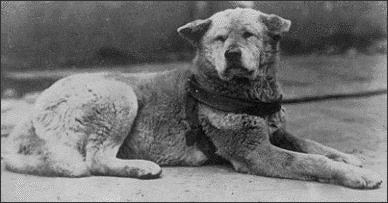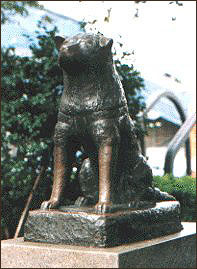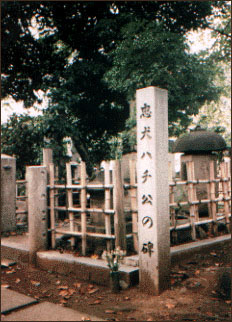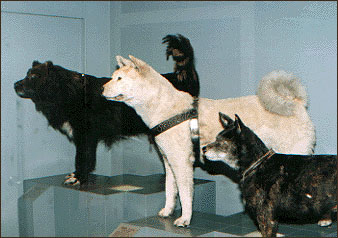|
Hachi-Ko

Photo: Akita-Inu Preservation Society Inc.
1932
_____________________________________________________________
One of
the most significant events in the restoration and preservation of the
Akita was the tremendous attention commanded throughout Japan and the
entire world by the moving story of an Akita dog named Hachi-Ko. No dog
before or since has so touched the hearts of people everywhere.
In
November 1923 a puppy was born in Akita Prefecture which showed great
promise of being of true Akita type. At the age of two months it was
sent to Professor Eizaburo Ueno in Tokyo, who had long coveted a fine
Akita dog. The Professor named the dog Hachi, and called him Hachi-Ko.
At that time, Professor Ueno's residence was in a suburb of Tokyo in the
vicinity of Shibuya Station, and he commuted by train from that station
to the agricultural experimental station at Nishikebara where he worked.
Hachi-Ko accompanied his master in the morning and in the evening as he
went to and from work.
On May
21, 1925, when Hachi-Ko was one and one-half years old, he was at
Shibuya Station as usual, waiting for his mater's arrival on the four
o'clock train. Professor Ueno would in fact never arrive, as he had been
struck down by a fatal stroke at the University that day.
Hachi-Ko was cared for by relatives and friends of the family, but he
continued to go to Shibuya Station each day to await his master's
arrival. Hachi-Ko's vigil continued until March 8, 1934, when at the age
of 11 years and 4 months he died, still waiting in vain for the return
of his beloved master.
Fiction could not have given birth to
such a sentimental story of fidelity, courage, and a dog's love of man.
Response throughout Japan, and indeed the whole world, was spontaneous,
as eulogies and warm words of condolence poured into Japan from young
and old, rich and poor.
Today, commuters through Shibuya
Station in Tokyo still must pass the imposing statue of Hachi-Ko,
erected in loving memory to the venerable dog. His proud figure,
sculptured in bronze and set high on a granite block, stands as a mute
evidence of the place in Japan's cultural and social history occupied by
the Akita dog.
______________________________________________
No story of the Akita would be
complete without mention of the rather extraordinary circumstances
surrounding the first Akita to come to America.
A famous American woman discovered
and learned to love the unique character and qualities of this
magnificent breed. What must have enraptured her most were the spiritual
rather than the physical characteristics of the Akita, for she had been
blind since birth. This woman was Helen Keller. She had learned of
Hachi-Ko and was touched by his story.
In 1937 at Akita City, Mr Ichiro
Ogasawara, a member of the Akita Police Department, presented Miss
Keller with one of his own new puppies, Kamikaze-Go. It should be
remembered that purebred Akitas were at that time virtually non-existent
outside of Akita Prefecture, and very scarce even there.
Kamikaze-Go returned to the Unites
States with Helen Keller abroad the liner Chichibu Maru. "Kami", as he
was affectionately called, went to live with Helen Keller at her estate
in a suburb of New York. Unfortunately, Kami became ill and died in
November of the same year at the tender age of eight months.
In June, 1939, a second Akita,
Kenzan-Go, was sent to Miss Keller from her admirers in Japan. Kenzan-Go
lived with Miss Keller until his death around 1944 or 1945.
So started the strange introduction
of the Akita to America, and the ensuing interest in this exotic breed
from Japan which finally culminated in recognition of the Akita in
America by the American Kennel Club in 1973.
The name Akita-Inu (Akita Dog) was not
used until September 1931, at which time the Akita was designated as a
natural monument. Prior to that time, dogs from Odate Region were called
the "Odate Dogs". During the Federal Period these dogs were called the
"Nambu-Inu" (Southern Regional Dog). Those dogs which were used for
fighting purposes were called either "Kuriya-Inu" while those used for
hunting by the mountain villagers were called "Matagi-Inu". The word
Matagi refers to hunter. |
Hachi-Ko Statue

at
Shibuya Station,
Tokyo.
Erected April 1934.
Sculptor: Shou Ando (born in Kagoshima).
Melt down during World War II.
Rebuilt August 1947.
Sculptor: Takushi Ando.
(Shou Ando's son; born in Kagoshima).
Hachi-Ko's Grave

at the corner of the grave of his master,
Dr. Ueno's grave, in Aoyama Cemetery,
Minami-Aoyama, Minato-ku, Tokyo.
Hachi-Ko preserved

(The National Science Museum,
Tokyo,
Ueno)
Center: Hachi-Ko
Left: South Pole Research survivor - Jiro
Right: Kai-Inu
(Kai: old name of parts of Nagano
and Yamanashi Prefectures)
________________________________________
Thus, since ancient times, Japanese
dogs were named according to their locale, or their roles as
domesticated animals.
It seems clear that the direct
forebears of the Akita as we know it today were native to Akita
Prefecture, the northernmost province on the main Japanese Island of
Honshu. The historical epicenter of the present day Akita is the City of
Odate in Akita Prefecture.
Three events which in combination
contributed significantly to focusing attention on the Akita dog during
the two decades preceding World War II were: the saga of Hachi-Ko, the
tour of Japan by Helen Keller and her involvement with the breed, and
the declaration of the Akita as a natural monument. Had these events not
occurred, one must wonder if the Akita, as a distinctive and
identifiable breed, would have survived.
That the Akita did survive the Second
World War is in itself a miracle, for that great conflict took its toll
of dogs as well as people. The Akita dog, which consumed the most food
among Japanese dogs, suffered greatly, and gradually dwindled in
numbers. |